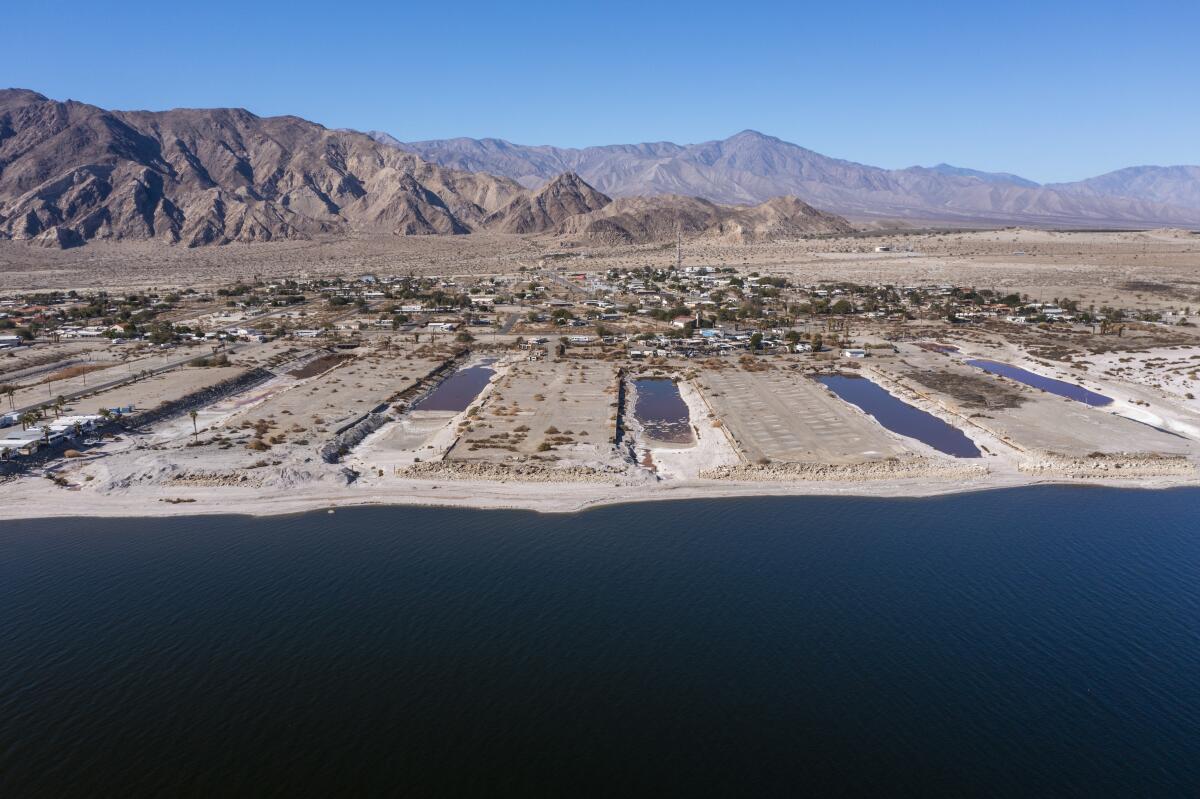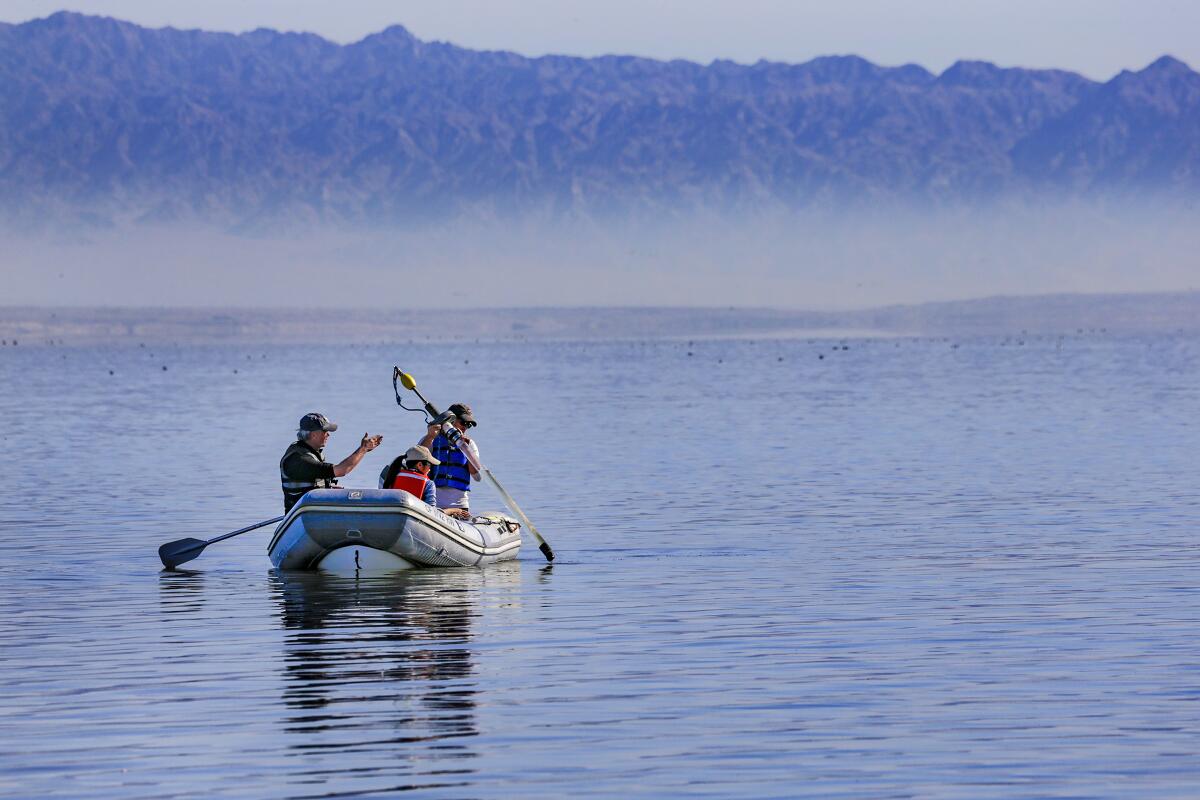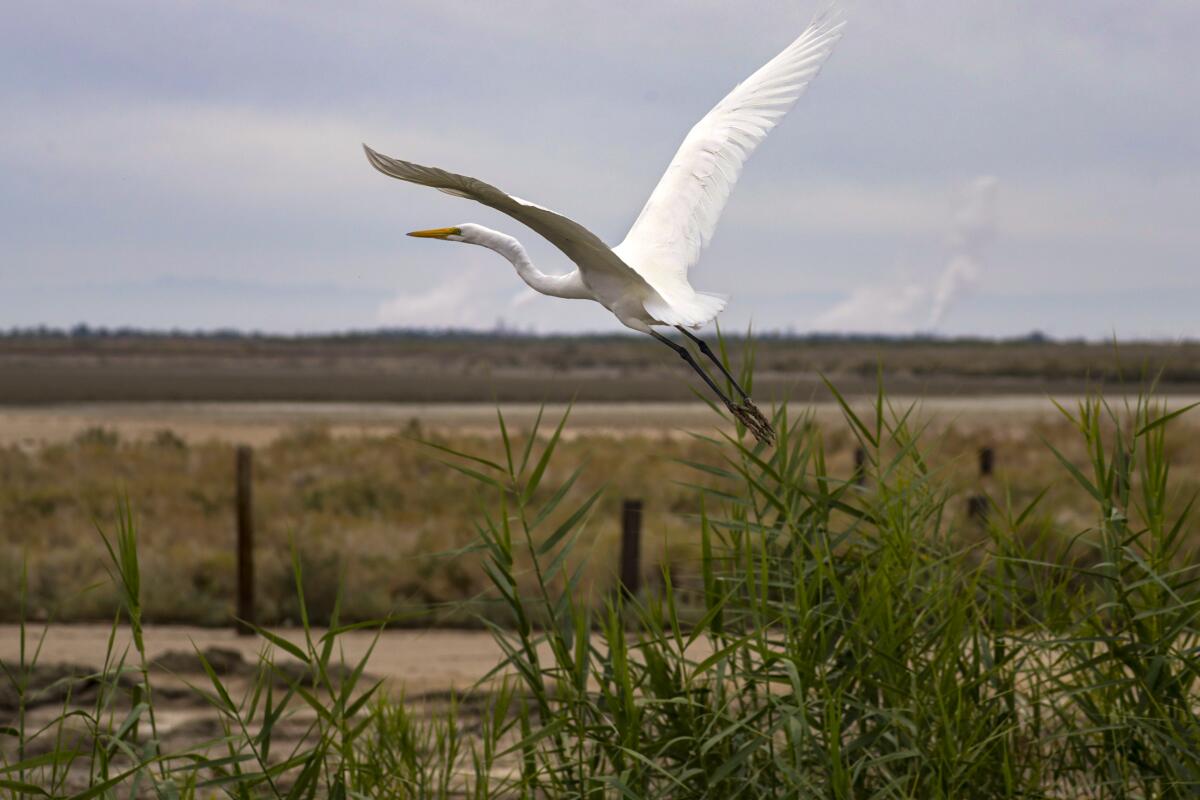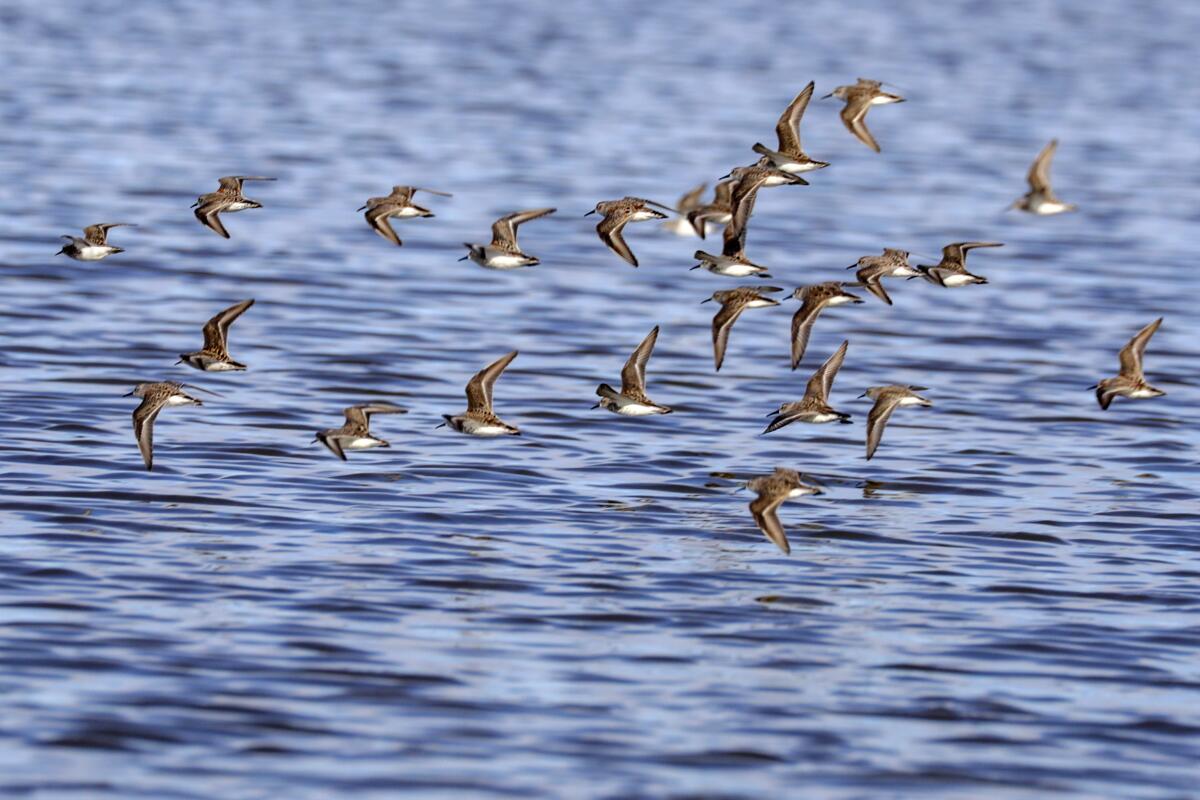As Salton Sea faces ecological collapse, a plan to save it with ocean water is rejected

- Share via
For as long as the Salton Sea has faced the threat of ecological collapse, some local residents and environmentalists have advocated a radical cure for the deteriorating lake: a large infusion of ocean water.
By moving desalinated seawater across the desert, they say, California could stop its largest lake from shrinking and growing saltier and could restore its once-thriving ecosystem. Without more water, they argue, the lake will continue to decline, and its retreating shorelines will expose growing stretches of dry lake bed that spew hazardous dust and greenhouse gases.
“The Salton Sea is drying up, along with water for our people and the environment,” the Salton City nonprofit the EcoMedia Compass says on its website. “Let’s ensure water resource sustainability for future generations, and import water from the ocean.”
But advocates of tapping ocean water were dealt a significant blow when a state-appointed panel of experts rejected the idea after a yearlong review.
The seven-member panel analyzed proposals that would involve desalinating seawater in Mexico, at the Gulf of California, also known as the Sea of Cortez, and sending it north across the border. The panel concluded that California shouldn’t pursue such a plan, citing costs estimated in the tens of billions of dollars, harm to the coastal environment and a construction timeline that would take many years before any water would reach the lake.
“It’s not feasible,” said Brent Haddad, an environmental studies professor at UC Santa Cruz who led the panel’s research team. “The panel feels that the state should no longer consider water importation from the Sea of Cortez to restore the Salton Sea.”
The panel presented its conclusions in two reports and discussed the findings in a virtual meeting last week.
The analysis has drawn condemnation from advocates of importing seawater, who argued that it was deeply flawed and seemed geared toward ruling out the concept.

“It’s a travesty,” said Tom Sephton, board president of the EcoMedia Compass. “What they did is essentially find a way to eliminate ocean water import from consideration for the indefinite future.”
Sephton, who runs a small demonstration desalination project at the Salton Sea, submitted one of the proposals that the panel considered. He strongly disagreed with the panel’s approach and cost estimates, calling the conclusions “completely bogus.”
The debate reflects a long-standing and entrenched rift over how California should deal with the Salton Sea’s worsening condition as the state adapts to recurrent droughts compounded by the effects of climate change.
While rejecting the idea of piping in ocean water, the panel instead recommended that the state negotiate a deal with the Imperial Irrigation District to pay farmers who would voluntarily leave farmland dry and contribute water to the lake.
Such an approach, which state officials have yet to endorse, would face major hurdles. Farmers in the Imperial Valley are already under pressure to reduce water use as part of efforts to prevent the Colorado River’s reservoirs from dropping to dangerously low levels.
The historic shortage on the river, amid a 23-year megadrought amplified by climate change, has left water agencies scrambling to secure water cutbacks to shore up Lake Mead, which stores a dwindling supply for California, Arizona, Nevada and Mexico.

The Salton Sea covers more than 300 square miles in Imperial and Riverside counties. It is nearly 240 feet below sea level in the Salton Trough, which over thousands of years has cycled between filling with Colorado River water and drying out.
The flooding river filled the Salton Sea from 1905 to 1907; it has since been sustained by water draining off farms in the Imperial Valley. The lake has been shrinking since the early 2000s, when the Imperial Irrigation District began selling a portion of its water to growing urban areas under an agreement with agencies in San Diego County and the Coachella Valley.
The lake’s level has declined about 11 feet since 2003. Its water is now about twice as salty as the ocean and continues to get saltier with evaporation, a shift that has caused drastic declines in fish and bird populations.
Along the dry shorelines, windblown dust contributes to harmful air pollution in low-income, predominantly Latino communities, where people suffer from asthma at high rates.
California’s 10-year plan for the Salton Sea, which came out in 2017, called for building nearly 30,000 acres of dust-control projects and wetland habitat around the lake by 2028.
After years of delays, workers with heavy machinery have been moving soil at the southern end of the lake as part of a 4,110-acre project aimed at suppressing dust and creating habitat for fish and birds.
In October 2021, state officials appointed the panel of experts, including water researchers and engineers, to study water importation concepts. The panel considered 18 ideas and found that all but three had “fatal flaws.”

In its summary report, the panel said that because the three proposals had similarities, they were combined into a single concept. This included building a large desalination plant at the Gulf of California, discharging the brine byproduct offshore and sending fresh water flowing 190 miles north through two steel pipelines. The concept also called for building a desalination plant at the Salton Sea to gradually reduce the salt content.
The panel estimated the initial cost at $65.7 billion or $78.4 billion, depending on the scenario, and rejected the concept “based on its high cost, environmental damage, minimal benefits to Mexico” and other issues.
The panel rejected an alternative that would have involved desalinating water in Mexico and exchanging the resulting fresh water for Colorado River water.
It instead recommended that the state work with the Imperial Irrigation District to develop a “voluntary, compensated fallowing program,” in which farmers would be paid to reduce water use. The goal would be to secure 145,000 acre-feet of water per year for the lake — more than 5% of the 2.6 million acre-feet that the IID diverts annually.
This approach would also include building a desalination plant that would take in water from the Salton Sea and put fresh water back. The brine would flow into evaporation ponds, and the dried salt would be loaded onto trains and shipped to landfills.
The panel estimated the initial cost at $17 billion.
Robert Glennon, a panel member and University of Arizona law professor, said the idea of importing water from the Gulf of California or the Pacific Ocean “didn’t make sense when there were alternatives for a fraction of the money, without the environmental harms, and that could be implemented much sooner.”
Glennon said speed is crucial to prevent the lake’s salinity from reaching “frightening levels.” He said the group’s recommendations would achieve salinity levels that enable fish to survive and birds to return and would include an “aggressive campaign of dust suppression.”
State officials said they will consider the panel’s findings as they prepare a long-range plan for the Salton Sea.
During the virtual meeting, Haddad said the panel recommends “stabilizing the sea at a smaller but still large volume and focusing on rapidly lowering its salinity.”
As he spoke, the Zoom chat filled with angry criticism. One listener wrote: “It is the worst possible solution.”
Some argued that the idea of asking farmers to fallow their fields is unrealistic given the Colorado River shortage. Haddad replied that doing this would be a “trade-off.” He said it would be up to the state to decide and to pursue negotiations with the Imperial Irrigation District.
Kerry Morrison, founder of the EcoMedia Compass and a longtime supporter of importing ocean water, said the original proposals were far cheaper than the one the panel analyzed.
“You didn’t take into account the economic feasibility of this,” Morrison told the panel. “We know it’s doable.”
Sephton, whose proposal was rejected, asked why the team decided on expensive pipelines instead of a canal, which would be far more economical. Sephton accused the panel of trying to make water importation appear impractical and expensive, saying it created a concept that was “designed to fail.”
“They vastly overinflated the cost of everything,” Sephton said.
Jenny E. Ross, a research affiliate of the Stout Research Center, said the panel recommended a “seriously misguided plan” that wasn’t previously disclosed and would rely on “unsustainable use of Colorado River water.”
Ross said the plan would result in shriveling the Salton Sea to a fraction of its size, worsening hazardous dust, and would cause large emissions of greenhouse gases. In her research, Ross has said that the collapse of the ecosystem and exposure of vast areas of lake bed — including sediment loaded with organic matter from decomposed aquatic life — would likely lead to a major increase in emissions of carbon dioxide and methane.
She said restoring the Salton Sea and reviving its ecosystem would have a positive effect by capturing and storing carbon.
“Ocean water importation is the only approach that can actually achieve true long-term restoration of the Salton Sea,” Ross said in an email. She said it’s also the only plan that would use a “guaranteed water supply independent of the Colorado River, thereby enabling the restored lake to be immune to the future vagaries of climate change and to increasing aridification.”
Proposals to pump ocean water between the Gulf of California and the Salton Sea have been discussed since the 1990s, initially to address rising salinity.
In the 1950s and 60s, when the Salton Sea was much less salty, it attracted tourists who fished and went boating and waterskiing. But by the 1990s, the lake’s eutrophic conditions were leading to mass die-offs of fish and birds. In recent years, rising salinity has further limited food sources for birds.
Some remnants of the lake’s heyday, including old buildings and docks, stand abandoned near the retreating shores.
Michael Cohen, a senior researcher with the Pacific Institute, has long criticized water import proposals, which he says are a “distraction from the real work that faces us, which is getting projects on the ground now.”
Cohen said that after years of delays, the state’s efforts are “starting to move in the right direction,” with funding and projects that will create thousands of acres of habitat and suppress dust.
He expects that the proposal to fallow farmland for the Salton Sea won’t happen at a time when California is already discussing the need for large cutbacks in Colorado River water. But the panel’s conclusions, he said, help “focus on the importance of near-term, feasible efforts” that can rely on available water supplies.
“We need to come to grips with the aridification of the West, in which there’s simply less water available,” Cohen said. “We need to live within our means. We can’t rely on pumping in large amounts of water from somewhere else.”
More to Read
Sign up for Essential California
The most important California stories and recommendations in your inbox every morning.
You may occasionally receive promotional content from the Los Angeles Times.











